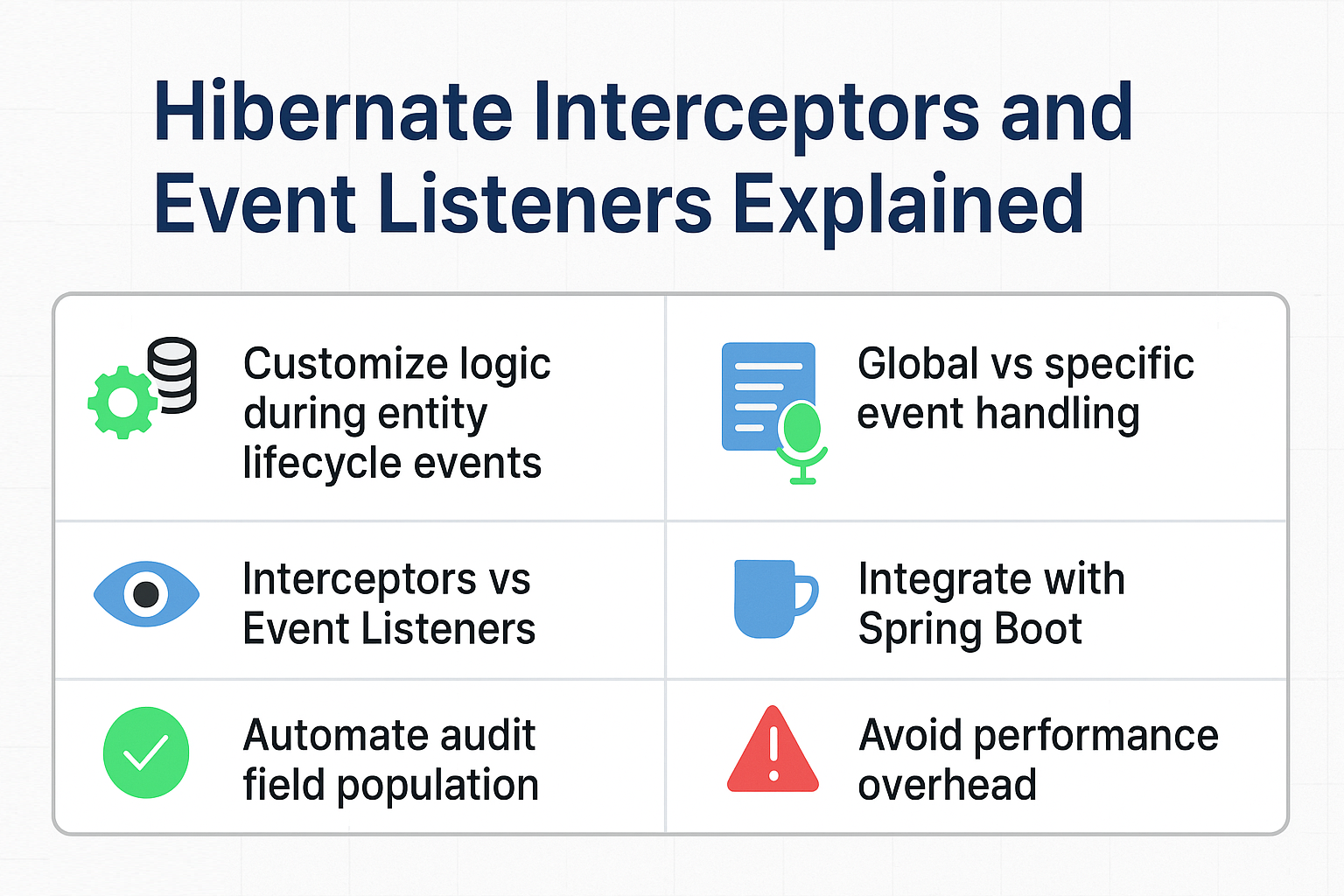In enterprise applications, it’s often necessary to perform custom logic during entity lifecycle events. Examples include auditing, logging, validation, or enforcing business rules whenever entities are saved, updated, or deleted.
Hibernate provides two powerful mechanisms for this:
- Interceptors
- Event Listeners
Think of interceptors as security cameras watching every action in your database session, while event listeners are like doorbells that ring only for specific events.
In this tutorial, we’ll dive deep into interceptors and event listeners, covering setup, use cases, pitfalls, and best practices.
What Are Hibernate Interceptors?
Interceptors allow developers to intercept Hibernate operations (like entity save, update, delete, or query execution) and perform custom logic.
Example: Basic Interceptor
public class AuditInterceptor extends EmptyInterceptor {
@Override
public boolean onSave(Object entity, Serializable id, Object[] state, String[] propertyNames, Type[] types) {
System.out.println("Entity saved: " + entity.getClass().getName());
return super.onSave(entity, id, state, propertyNames, types);
}
@Override
public boolean onFlushDirty(Object entity, Serializable id, Object[] currentState, Object[] previousState,
String[] propertyNames, Type[] types) {
System.out.println("Entity updated: " + entity.getClass().getName());
return super.onFlushDirty(entity, id, currentState, previousState, propertyNames, types);
}
}
Attaching an Interceptor to SessionFactory
SessionFactory sessionFactory = new Configuration()
.configure("hibernate.cfg.xml")
.setInterceptor(new AuditInterceptor())
.buildSessionFactory();
Now every save or update will trigger custom logic.
What Are Hibernate Event Listeners?
Event listeners allow you to hook into specific entity lifecycle events. Unlike interceptors, they provide finer-grained control.
Example: SaveOrUpdate Listener
public class AuditEventListener implements SaveOrUpdateEventListener {
@Override
public void onSaveOrUpdate(SaveOrUpdateEvent event) throws HibernateException {
Object entity = event.getEntity();
System.out.println("Entity SaveOrUpdate event: " + entity.getClass().getName());
}
}
Registering Event Listeners
Configuration configuration = new Configuration().configure();
configuration.getEventListeners().setSaveOrUpdateEventListeners(new SaveOrUpdateEventListener[]{new AuditEventListener()});
SessionFactory sessionFactory = configuration.buildSessionFactory();
Comparison: Interceptors vs Event Listeners
| Feature | Interceptors | Event Listeners |
|---|---|---|
| Scope | Session-wide or global | Specific events (insert, update, delete, load, etc.) |
| Use Case | Logging, auditing, query interception | Entity lifecycle hooks |
| Complexity | Easier, less granular | More granular control |
| Example | onSave, onDelete, onFlushDirty |
PreInsertEventListener, PostUpdateEventListener |
Example Use Case: Auditing with Event Listeners
Suppose we want to automatically set audit fields (createdAt, updatedAt) on entities.
Entity
@Entity
@Table(name = "employees")
public class Employee {
@Id
@GeneratedValue(strategy = GenerationType.IDENTITY)
private Long id;
private String name;
private String department;
private LocalDateTime createdAt;
private LocalDateTime updatedAt;
// getters and setters
}
PreInsert and PreUpdate Listeners
public class AuditInsertListener implements PreInsertEventListener {
@Override
public boolean onPreInsert(PreInsertEvent event) {
if (event.getEntity() instanceof Employee) {
Employee emp = (Employee) event.getEntity();
emp.setCreatedAt(LocalDateTime.now());
}
return false;
}
}
public class AuditUpdateListener implements PreUpdateEventListener {
@Override
public boolean onPreUpdate(PreUpdateEvent event) {
if (event.getEntity() instanceof Employee) {
Employee emp = (Employee) event.getEntity();
emp.setUpdatedAt(LocalDateTime.now());
}
return false;
}
}
Integration with Spring Boot
In Spring Boot, you can configure interceptors and event listeners via beans.
@Configuration
public class HibernateConfig {
@Bean
public HibernatePropertiesCustomizer hibernateCustomizer() {
return props -> props.put("hibernate.ejb.interceptor", new AuditInterceptor());
}
}
For event listeners, Spring Data JPA allows using @EntityListeners annotation:
@Entity
@EntityListeners(AuditEntityListener.class)
public class Employee { ... }
Where AuditEntityListener is a JPA callback listener (@PrePersist, @PreUpdate, etc.).
Common Pitfalls & Anti-Patterns
- Overusing Interceptors → Adds performance overhead.
- Complex Logic in Event Listeners → Slows down entity operations.
- Ignoring Transaction Boundaries → Audit logic must consider rollback scenarios.
- Mixing Interceptors and Listeners without Strategy → Leads to unpredictable behavior.
Best Practices
- Use interceptors for generic cross-cutting concerns (logging, query modification).
- Use event listeners for fine-grained entity lifecycle actions (auditing, validation).
- Keep interceptor/listener logic lightweight.
- Always test for performance impact under real load.
- Prefer JPA
@EntityListenersfor portability across ORMs.
📌 Hibernate Version Notes
Hibernate 5.x
- Uses legacy
org.hibernate.eventAPIs. - Event listeners configured via
Configurationclass. - Interceptors set at
SessionFactoryor session level.
Hibernate 6.x
- Migrated to
jakarta.persistence. - Improved support for JPA entity callbacks (
@PrePersist,@PostLoad, etc.). - More flexible event system with better integration for Spring Boot.
Conclusion & Key Takeaways
- Interceptors → Good for cross-cutting concerns.
- Event Listeners → Best for entity lifecycle events.
- Both mechanisms enhance auditing, logging, and data integrity.
- Choose the right tool for the job and keep logic efficient.
FAQ: Expert-Level Questions
Q1: What’s the difference between Hibernate and JPA?
Hibernate is a JPA implementation that also provides extra features like interceptors and event listeners.
Q2: How does Hibernate caching improve performance?
It reduces redundant database queries by storing frequently accessed data in memory.
Q3: What are the drawbacks of eager fetching?
It loads too much data upfront, causing memory and performance issues.
Q4: How do I solve the N+1 select problem in Hibernate?
Use fetch joins, batch fetching, or entity graphs.
Q5: Can I use Hibernate without Spring?
Yes, Hibernate can run standalone with SessionFactory.
Q6: What’s the best strategy for inheritance mapping?
Depends on requirements: SINGLE_TABLE, JOINED, or TABLE_PER_CLASS.
Q7: How does Hibernate handle composite keys?
Using @Embeddable and @EmbeddedId or @IdClass.
Q8: How is Hibernate 6 different from Hibernate 5?
Hibernate 6 uses jakarta.persistence and improves lifecycle event handling.
Q9: Is Hibernate suitable for microservices?
Yes, though lightweight ORMs like jOOQ or MyBatis may be better for smaller services.
Q10: When should I not use Hibernate?
Avoid Hibernate when raw SQL control or maximum performance is required (e.g., analytics-heavy systems).
